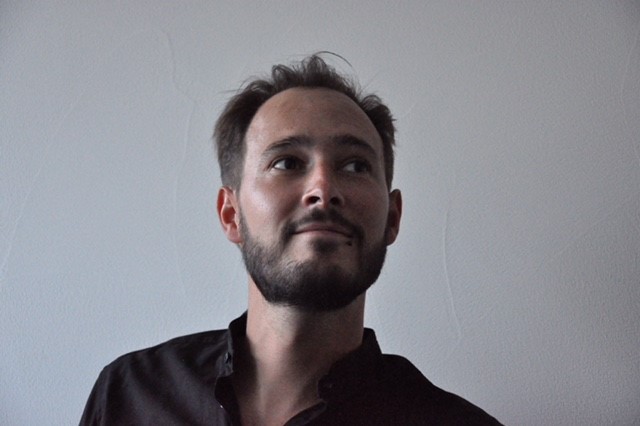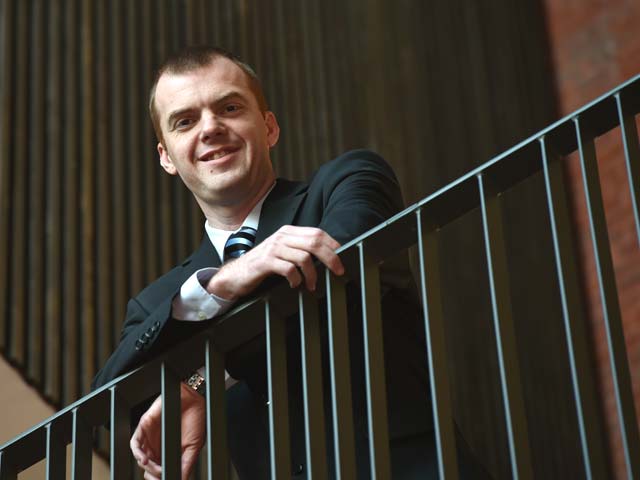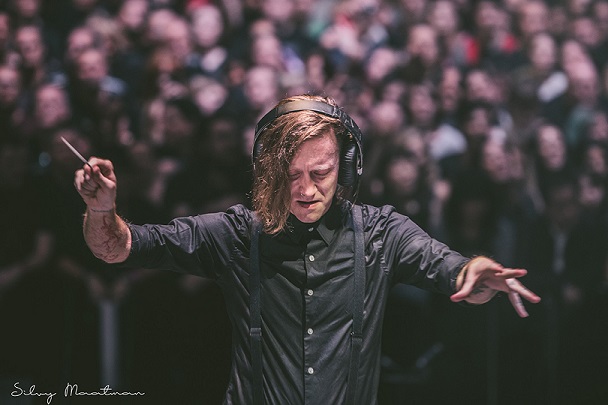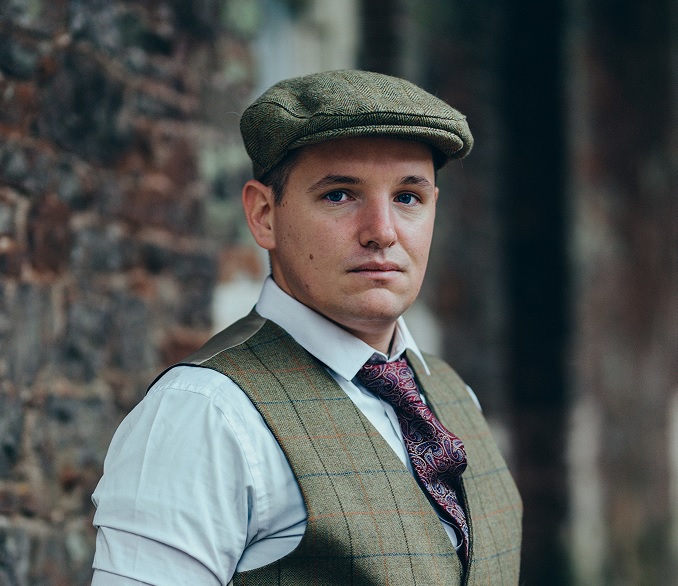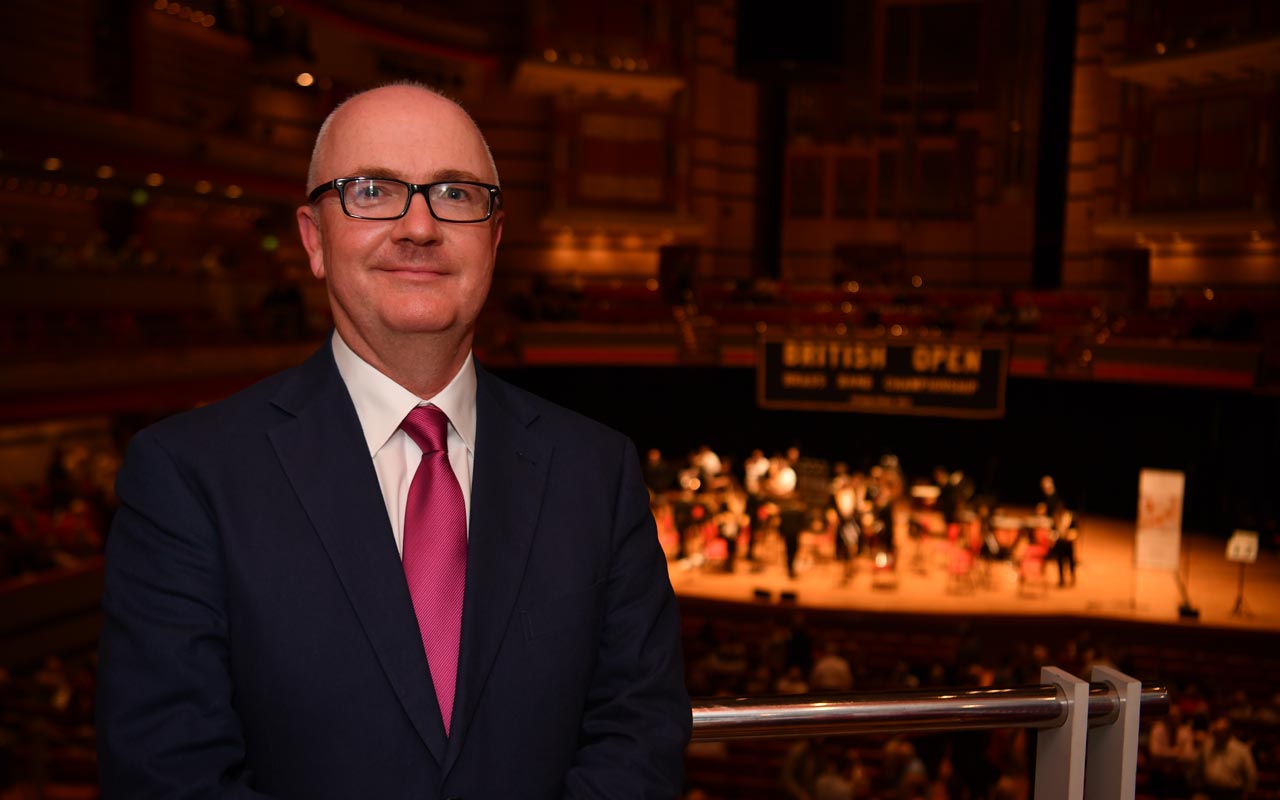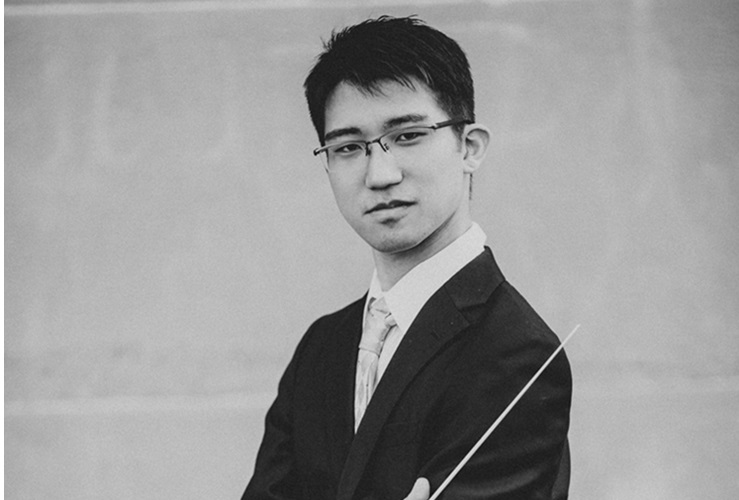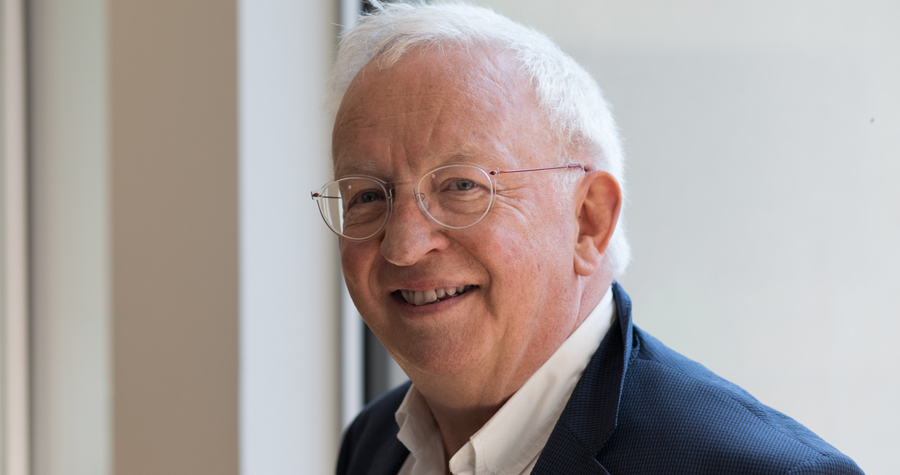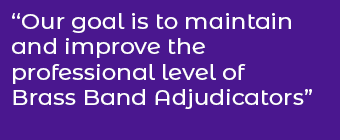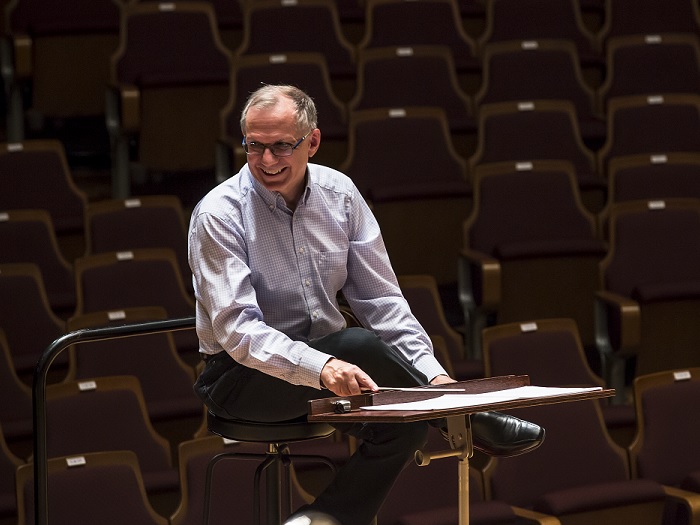
Philip Sparke’s music is synonymous with the European Championships.
This year he provides the Championship Section set-work for a fifth time – following ‘The Land of the Long White Cloud’ (1980), ‘The Year of the Dragon’ (1986), ‘A London Overture’ (1991) and ‘Tallis Variations’ (2000).
Round 80
However, he has also had 14 different works performed 79 times in total as own-choice selections – led by what will be the 17th performance of ‘Music of the Spheres’ this year to make it a round 80.
Heaton’s ‘Contest Music’ and Sparke’s classic ‘Harmony Music’ are in second and third place on the play list podium, with 15 and 14 performances respectively, whilst Philip Wilby (48 own-choice performances of eight works) and Edward Gregson (41 from 9) lag a little way behind in the overall stakes.
So will these works be performed time and time again in the years to come or will they enjoy just a fleeting moment in the European performance spotlight?
Cataclysms (Roland Szentpali)
Written in 2019, 'Cataclysms' is inspired by a trio of global destructive phenomena - the natural disasters that befall humanity.
It opens with 'Tsunami' - and a bucolic introduction evoking a 'calm coast' blissfully unaware of the terror that will soon engulf it.
The evocative writing draws on the timeline that follows; an 'open sea', 'wind and waves', 'earthquake in the deep', 'decrease in water' and 'tidal waves' - the mounting tensions that prelude the cataclysmic release of natural forces, the eventual return to the 'calm coast' revealing the trail of devastation.
The final coda poses the question of whether we are to blame and whether climate change is now creating a sense of natural imbalance that the earth itself is trying to redress.
The second movement ('Tornado') again evokes a timeline of disaster and that of 'hot weather', 'three storms', 'supercell' and 'hitting the ground' as a huge tornado stack strikes. The aftermath once more reveals a landscape denuded of life — homes blown apart like confetti in the wind.
The final section ('Volcanic Eruption') starts as a meditative tribute to the natural glories of mother earth — 'soil, trees, flowers, animals'.
The paradise is soon disturbed rumbling deep in the earth's core - 'tectonic activities' that soon shake the earth below the feet, exploding in eruption; the molten magma slowly but inextricably destroying everything in its path.
Man is impotent to stop the forces of nature.
The final coda poses the question of whether we are to blame and whether climate change is now creating a sense of natural imbalance that the earth itself is trying to redress.
Iwan Fox
Dear Cassandra (Ludovic Neurohr)
Concerto No. 14 for Brass Band
Cassandra was cursed by the Gods to utter portents and prophesies that although true, no one believed.
She foresaw the destruction of Troy; warning of the ‘gift’ of the Wooden Horse from the Greeks. Murdered by an avenging wife she is said to have left a chest behind that when opened would see the person who peered inside cursed by madness.
‘Dear Cassandara' takes the form of musical ‘open mail’ that asks conductors to interpret the composer’s complex prophetic questioning to shape their own future contesting destiny.
Murdered by an avenging wife she is said to have left a chest behind that when opened would see the person who peered inside cursed by madness.
The three linked movements are played as a whole, although each element in turn is divided into detailed paragraphs of musical discourse.
It opens with an extended exploratory introduction, releasing textures, dynamic and effects from single and ensemble lines. ‘The Call’ section that follows is an underlying rhythmic sequence representing the cipher title of the work.
‘Fear’ sees the music delve into a world of electronic pop rock; fevered and rhythmic, before ‘Tests’ and ‘High Hopes’ take the form of overlapping quasi-cadenza solos.
‘No Matter’ turns into a prophetic response with the use of a theme from Pergolesi Thema’s ‘Stabat Mater’, before the ‘Finale’ seeks to dispel doubt once and for all in glorious affirmation of the composer’s own journey to finding musical fulfilment.
Iwan Fox
Fraternity (Thierry Deleruyelle)
Thierry Deleruyelle’s work was originally commissioned as the set-work for the 2016 European Championship in Lille, and was received with widespread popular and critical acclaim.
It is inspired by the tragic circumstances of a 1906 mining disaster in Douai in France that claimed over 1,000 lives, and is written in an open, tonal fashion - eschewing high-energy injections of volume and speed for more considered pacing and texture, subtly scored balances and lengthened lyrical lines.
The catastrophe is ignited by a fractured, frenzied forcefulness, the prelude to which is the ghostly on-rush of air through instruments; life or death a matter of luck.
The musical narrative, with nods of Gallic appreciation to the likes of composer Paul Dukas sets the scene, and telling the tale and recalling the aftermath in seven linked sections; from the ‘Black Land’ and ‘Towering Colliery’ above ground, to the journey to the face to extract the coal.
The catastrophe is ignited by a fractured, frenzied forcefulness, the prelude to which is the ghostly on-rush of air through instruments; life or death a matter of luck.
The solemn task of bringing out the dead leads to a bleak paean of reflection, before the piece ends in uplifting fashion in the form of a 'Fraternity Prayer' that pays tribute to those lost.
Iwan Fox
Jesus in Tibet (Simon Dobson)
Simon's Dobson's work references an unsubstantiated supposition that Jesus Christ may have spent most of his adolescent and adult life not in Judea, but much further afield.
It is noted that there is no Biblical reference of Jesus from the ages of 12 to 30 — a singular omission that could be explained by his travels in search of the purity of eastern philosophy.
Mention is made of such a man in the Gospel of St. Issa (Issa the Arabic name of Jesus in Islam) found in a monastery in the Himalayas.
It tells of a prophet devoting himself to Buddhist teachings in Tibet for many years — and perhaps even for the rest of his life. If this were true, it would turn the world upside down.
It is noted that there is no Biblical reference of Jesus from the ages of 12 to 30 — a singular omission that could be explained by his travels in search of the purity of eastern philosophy.
The composer explores the possibilities in five linked movements.
'Three Kings from The East' not only witness his birth but prophesize his calling to the east. 'Songs of Second Temple' takes place before the destruction of Herod's second temple, and the sounds of ancient Shofar horns that accompanied it.
'The Silk Road' marks Jesus' travel along the famous trading route, whilst 'St. Issa' marks his final arrival and devotion to a peaceful, serene meditation.
'Nirvana or Retribution' sees Jesus' return to his homeland and his Biblical destiny — although the music leaves an open question to whether that is indeed what happened.
Perhaps he was crucified and reached enlightenment. Perhaps he fled and lived out his life in quiet meditation in the hills of Kashmir in India?
Iwan Fox
Karma (Ludovic Neurohr)
Concerto No. 20 for Brass Band
Ludovic Neurohr’s work is a study in the self-analysis of the psyche of the composer.
At its core lies the importance he places on conveying emotions through harmony and contrapuntal lines; the ability to evoke intense emotions and weave complex melodic voices, creating a richly captivating soundscape to provide an immersive experience.
In doing so he pays respect to those he believes have successfully done that - notably Philip Sparke and Peter Graham, whom he honours with tribute in pastiche homage.
The structure to explore this relates to his understanding of 'Karma'; reflections of energy, strength, and agility in the opening section creating a complex tapestry of ideas - Sparkesque in inspiration.
The slow movement is imbued with pain and emotional intensity; a journey of meditation, evoking complex feelings – what the composer calls “a tour de force for the soloists”.
In doing so he pays respect to those he believes have successfully done that - notably Philip Sparke and Peter Graham, whom he honours with tribute in pastiche homage.
In the final movement, all memories and understanding is revisited with renewed intensity.
Familiar musical themes intertwine, creating a vibrant melodic weave that evokes the highlights of the musical journey, playful and inventive in a manner of Peter Graham.
For the composer it sums up his personal Karma - a mysterious and benevolent force, which fully manifests itself and rewards the composer for past trials.
This happy denouement gives him, and hopefully the audience an experience of profound satisfaction and joy. The music gently dissipating leaving a sense of accomplishment.
Iwan Fox
Sand and Stars (Thierry Deleruyelle)*
'Sand and Stars' is the fourth narrative chapter in the composer's 20th century lineal celebration of the spirit of human resilience.
It follows 'Fraternity', 'No Man's Land' and 'The Crazy Twenties' and takes its inspiration from the true story of aviator and novelist Antonie de Saint-Exupery, who in 1935 set out to break the flight record Paris to Saigon.
Nearly 20 hours into the attempt he, alongside navigator Andre Prevot, crashed into the sands of the Libyan desert, their outlook as bleak as the never-ending horizon before them. Miraculously they survived for three days before close to death they encountered a Bedouin tribesman who led them to safety.
Instead, it dealt with themes of friendship, death, heroism and humanity. The English title 'Wind, Sand and Stars' came later, as did the best-selling book 'The Little Prince'.
It saw de Saint-Exupery to write the memoir, 'Terre des hommes' ('Land of Men'). Although centred on the incident it was not an adventure story.
Instead, it dealt with themes of friendship, death, heroism and humanity. The English title 'Wind, Sand and Stars' came later, as did the best-selling book 'The Little Prince'.
In contrast, Deleruyelle is directly inspired by the adventure, and to a lesser extent the other themes.
The work follows a readily identifiable narrative line (mirroring his other compositions) from the opening 'Le Bourget' take off and the 'extraordinary adventure ahead' that follows. 'The Crash' is a whirling nosedive in the sand.
The 'lament' that follows is a bleak realisation of their isolated situation as they embark on their trek to safety with thoughts of Arabic dances filling their minds before the miracle of their rescuer appears out of the haze of the desert sands.
Iwan Fox
* To be performed 3 times
The Falcon in the Snow (Paul Saggers)
‘The Falcon in the Snow’ is a depiction of British explorer Robert Falcon Scott’s ill-fated expedition to reach the South Pole.
It is divided into five sections, each headed by quotes from Scott’s own journal:
‘Saturday November 26, 1910’ sees the party depart, finally arriving at the Ross Ice Shelf in January 1911. There they establish a base camp to their began preparations for the push to the Pole. ‘Thursday February 2, 1911’ recounts the harsh challenges faced of weather, terrain, supply lines and the endless bleakness.
‘Tuesday January 16, 1912’ is the culmination of endeavour and disappointment as they fine that Roald Amundsen had beaten them to the South Pole by 34 days.
Tragically, Scott and his companions, Edward Wilson, Henry Bowers, Lawrence Oates, and Edgar Evans all perish, their final resting stop to become their tomb.
‘Thursday January 18, 1912’ sees then start they 800-mile trek back – an interminable, arduous journey. Tragically, Scott and his companions, Edward Wilson, Henry Bowers, Lawrence Oates, and Edgar Evans all perish, their final resting stop to become their tomb.
‘Thursday March 29, 1912’ is to be Scott’s final entry in his journal. “For God’s sake look after our people”.
Despite the tragic outcome, Scott's expedition contributed significantly to the understanding of the Antarctic region.
The scientific research and specimens collected during the journey provided valuable insights into the continent's natural history and biology, whilst his own legacy was enhanced by the heroic nature of his failure.
Iwan Fox
The Triumph of Time (Peter Graham)
Peter Graham’s work was commissioned by Black Dyke Band and premiered by them at the 37th European Brass Band Championships held in Scotland in 2014.
It draws its inspiration from the 25th anniversary of one of the composer’s earliest works for the medium, ‘The Essence of Time’, which was also used as a European set-work in Scotland in 1989.
Like it, ‘The Triumph of Time’ is a set of linked variations which follow roughly the same moods and characteristics of its older musical sibling – although not using any of the original material, nor referring to its Ecclesiastes biblical references.
It draws its inspiration from the 25th anniversary of one of the composer’s earliest works for the medium, ‘The Essence of Time’, which was also used as a European set-work in Scotland in 1989.
Instead, the composer uses some of its structural elements to draw on what he calls its ‘energy, optimism and sheer joie de vivre’ to evoke a celebratory spirit of hopefulness and passionate vibrancy.
However, he also encompasses elements of mature reflection on the passing of time in exploring unfamiliar compositional concepts within his familiar lyrical style of writing.
This comes with a flugel led focal point marked semplice e molto cantabile followed by a trademark pianissimo ensemble chorale before the glorious recapitulation that drives the music things to a conclusion that throbs with justification.
Iwan Fox
Weeping Willow (Hitoshi Takahashi)
Weeping willows (Salix Babylonica) can be found throughout Japan. In city of Kyoto, they line beautiful paths along the old city centre.
The composer uses them as a metaphor for his own emotional identity and language – an expression of his ongoing emotional state of well being. It is one that has seen him suffer severe depression and contemplate ending his own life, yet at its lowest point starts a progressive return to hopefulness and positivity.
The work is structured into an introduction and three parts, roughly in sonata form.
The opening projects pain and deep despair – the beginning of the dark psychological state struck by the sound of an anvil and a liner theme much like the extended drooping branches of the willow tree.
The cadenza that follows is his homage to Chopin's ‘Polonaise-fantasie’ that expresses hope and the dream of a happy future life.
The cadenza that follows is his homage to Chopin's ‘Polonaise-fantasie’ that expresses hope and the dream of a happy future life.
It is a deeply personal reflection. The composer says his “heart is broken and feels like broken glass’ - the ‘fear’, ‘suffering’ and ‘heartache’ the emotions felt whilst receiving clinical help.
There is a flicker of positivity however, marked by a slow ascension that signals the desire for self-confidence. At this point the 'fear' motif finally develops into a resonating sense of emerging positivity with extensive use of Japanese scales and harmonies.
A chromatic finale leads to a climax that concludes with a hammer blow of a different kind – one symbolising hope.
Iwan Fox
Z 1920 - Scenes from a Silent Movie (Peter Graham)
The 1920 silent movie, ‘The Mark of Zorro’ is a swashbuckling adventure story starring Douglas Fairbanks and Marguerite De La Motte.
Based on a 1919 story by Johnston McCulley entitled ‘The Curse of Capistrano’ which was serialised in five issues of the pulp magazine 'All Story Weekly', it tells the tale of Don Diego Vega, a foppish son of a wealthy Californian Hispanic landowner whose alter-ego is Senor Zorro.
Determined to help local peasants fight the corrupt administration of Governor Alvarado and his henchman, the villainous Captain Juan Ramon, he creates havoc to hamper their evil plans.
Falling in love with Lolita Pulido (who is also harassed by Captain Ramon), but unable to reveal his true identity, he succeeds with his swift swordplay and acerbic humour - leaving his mark on those who cross him by scarring them with the letter ‘Z’ across their faces.
On in victory does he reveal his true identity – much to the delight of Lolita - winning her hand in marriage to live happily ever after (or due to the success of the film, a number of sequels).
Falling in love with Lolita Pulido (who is also harassed by Captain Ramon), but unable to reveal his true identity, he succeeds with his swift swordplay and acerbic humour - leaving his mark on those who cross him by scarring them with the letter ‘Z’ across their faces.
The main characters are represented within the score with Don Diego Vega/Zorro played by two cornets, Lolita (horn) and Captain Ramon (euphonium).
The narrative is revealed by the composer in five linked scenes, employed he says, “with his own creative licence” to the original storyline and an appreciation to the swashbuckling heroism, adventure, romance and passion found in echoes of traditional brass band values of lyricism, virtuosity and bravura
Scene 1: A desolate town square - a people oppressed - the arrival of Zorro
Scene 2: Lolita, a damsel in distress
Scene 3: Captain Ramon and Zorro prepare to duel with a sword fight in the tavern
Scene 4: Don Diego’s heart is stolen with a tango at the hacienda
Scene 5: Zorro is unmasked, the oppressor vanquished. Zorro and Lolita are reunited
Iwan Fox
Challenge Section:
Music of the Spheres (Philip Sparke)
‘Music of the Spheres’ was written late 2003/early 2004 and reflects the composer's fascination with the origins of the universe and deep space.
The title comes from a theory, formulated by Pythagoras, that the cosmos is ruled by the same laws that govern the ratios of note frequencies of the musical scale - ‘Harmonia' in Ancient Greek, which means scale or tuning as Greek music was monophonic.
He also believed that these ratios corresponded to the distances of the six known planets from the sun and that the planets each produced a musical note which combined to weave a continuous heavenly melody. These six notes form the basis of the sections ‘Music of the Spheres’ and ‘Harmonia’.
The title comes from a theory, formulated by Pythagoras, that the cosmos is ruled by the same laws that govern the ratios of note frequencies of the musical scale
It opens with a horn solo ‘t = 0’; a name given by some scientists to the moment of the Big Bang, when time and space were created. It is followed by its depiction, as the universe bursts from a single point of origin.
‘The Lonely Planet’ is a meditation on the unlikely set of circumstances which led to the creation of the Earth as a planet that can support life, as well as the search for other civilisations, whilst ‘Asteroids’ and ‘Shooting Stars’ depict both the benign and dangerous objects flying through space.
The work ends with ‘The Unknown’ - leaving in question whether our continually expanding exploration of the universe will eventually lead to enlightenment or destruction.
Iwan Fox
Of Distant Memories (Edward Gregson)
'Of Distant Memories' (Music in an Olden Style) was commissioned to mark the centenary in 2013 of the first original test-piece used at the National Championships of Great Britain.
It has since gained critical acclaim; a tone-poem of adaptive test-piece facadism that pays homage to composers such as Fletcher, Holst, Bliss, Howells and Vaughan Williams, who gave the brass band movement a foundation of distinguished original works on which to build.
It is a familiar, yet distinctive recall of reminiscences from contesting time past, written within a contemporary structure to present the listener with an outward valence of familiarity; subconscious memories which in turn trigger an inner amalgamation of modern configurations.
a tone-poem of adaptive test-piece facadism that pays homage to composers such as Fletcher, Holst, Bliss, Howells and Vaughan Williams, who gave the brass band movement a foundation of distinguished original works on which to build.
Gregson’s ‘contemporary colouristic terms’ (as he himself states) are far removed from the original palette shadings of ‘Epic Symphony’ and ‘Severn Suite’, but are never garish, or disrespectful.
There is an affectionate nod to ‘Labour and Love’ and ‘Epic Symphony’ amongst others, but Gregson also revels in other elements of sublime detail - little motifs and interventions - that add a spark of sharply focused, intellectual wit; from a little snippet of Alban Berg to a touch of Leonard Bernstein.
Tradition is retained, but not at the expense of flexibility. It is such an engrossing feature throughout a wonderful composition.
Iwan Fox
Paganini Variations (Philip Wilby)
An iconic work for the brass band medium, ‘Paganini Variations’ was commissioned by the BBC in 1990 for the BBC Band of the Year, and is inscribed “For Paul Hindmarsh”, then a BBC producer.
Its genius is that it is readily accessible to both players and audience alike but remains a fiendishly difficult test of technique and nerve.
The famous 24th Caprice has been worked, re worked and worked again by the composer, combining the historical and the personal strands of inspiration to take the listener from the early 19th century and the roots of the early brass band repertoire right through to the modern day.
It’s greatness as a work is never questioned however many times you hear it played.
Each of the sixteen variations explores these avenues to the full – some romantic, some sombre, others brilliant and brash in style (the key to making each work successfully – not pace or dynamic), whilst the underlying theme remains intact. It is a tour de force.
Even today, only very fine bands really master its challenges, although everyone enjoys its challenges. The soloists have plenty to do, whilst every section of the band is stretched by the demands placed upon them.
It’s greatness as a work is never questioned however many times you hear it played.
Iwan Fox




